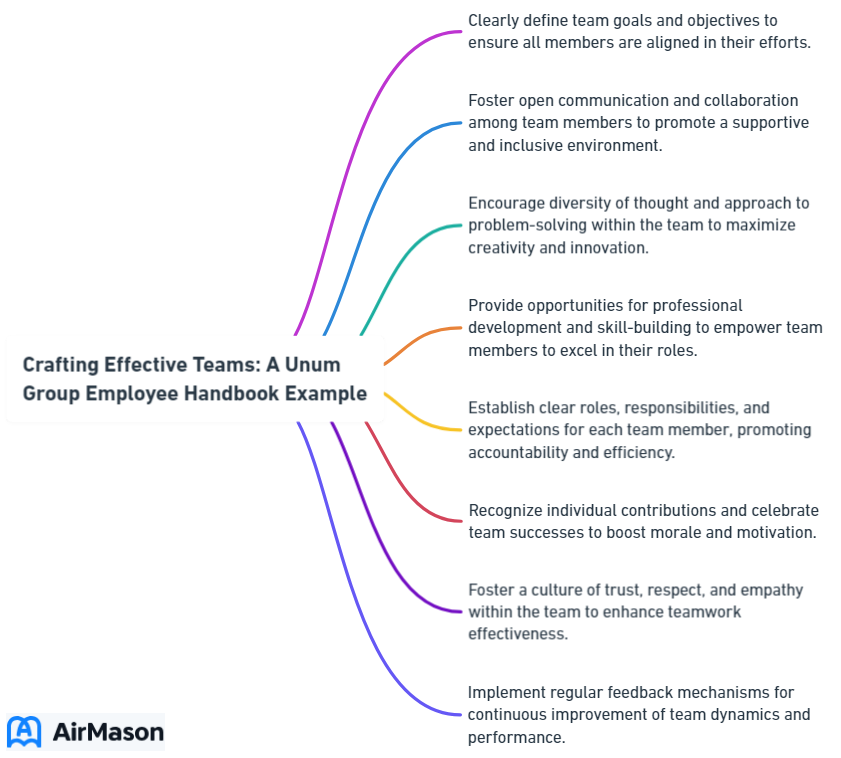
Are you aiming to create an employee handbook that effectively guides and supports your team? By examining a Unum Group employee handbook example, you’ll gain insight into essential components like cultural ethos, solid policies, comprehensive benefits, and legal safeguards. In this article, we distill Unum’s best practices and provide actionable tips to tailor a robust employee handbook for your company’s unique needs.
Key Takeaways
- A comprehensive employee handbook is vital for conveying company culture, expectations, and employee benefits, ensuring clear communication and consistency within the organization.
- Employee handbooks must be tailored to individual business needs, taking into account industry-specific regulations, company size and structure, and unique work arrangements such as remote work policies.
- Regular updates and legal considerations are crucial for maintaining an effective employee handbook, which should comply with labor laws and protect employee confidentiality and privacy.
Fortune 500 Companies Employee Handbook
Welcome to the Fortune 500 Companies Employee Handbook, a comprehensive guide designed to navigate your journey within our esteemed organization. In this handbook, you will find essential information about our corporate culture, values, and expectations. The Fortune 500 Companies Employee Handbook serves as your go-to resource for understanding our policies, benefits, and the shared commitment to excellence that defines our workforce. Whether you are a new hire or a seasoned professional, this handbook is your roadmap to success, ensuring a harmonious and productive experience for every member of our dynamic team. Explore the pages ahead to discover the tools and insights that will empower you in your role and contribute to the collective success of our Fortune 500 family.
Creating a Comprehensive Employee Handbook
Developing a comprehensive employee handbook serves as a cornerstone for building the company’s relationship with its employees. This document is not just about rules and regulations; it is a reflection of the company’s culture, mission, and values. It serves as a roadmap guiding employees through their journey within the organization, setting clear expectations, and providing an overview of the benefits they can avail.
A comprehensive employee handbook should convey the company’s policies and procedures clearly, without any legal jargon. This ensures that the employees are well aware of the company’s expectations, fostering a sense of consistency across the organization. It also provides an overview of the various benefits offered by the company, ensuring employees understand their entitlements and the resources available to them.
Company mission and values
The company’s mission and values are the heart and soul of the employee handbook. They convey the company’s purpose and the principles it stands by. These values provide a blueprint for the company’s culture, setting the tone for the work environment and influencing employee behavior. They ensure that all employees, regardless of their roles, are on the same page, working towards a common goal.
Effectively conveying these values is critical. It involves:
- Stating the mission statement
- Making clear the company’s ambitions and the reasons behind the values
- Input and active engagement from key stakeholders to ensure that the values resonate with the workforce
- Fostering a sense of belonging and commitment

Policies and procedures
Policies and procedures are the backbone of an employee handbook. They define the company’s expectations and guidelines, ensuring that all employees understand the rules of the game. From health and disability insurance information to leave policies and codes of conduct, a comprehensive list of policies ensures transparent communication and consistency across the organization.
The development of these policies and procedures necessitates a delicate balance between clarity and comprehensiveness. The use of simple language, avoidance of complex jargon, and regular updates are essential to keep the policies clear and up-to-date. Furthermore, formatting techniques like using headings, subheadings, and bullet points can enhance readability, ensuring employees understand the expectations set forth by the company.
Employee benefits overview

Employee benefits are a critical component of an employee’s compensation package. They can influence an employee’s decision to join or stay with a company. These benefits extend beyond the basic salary, offering the added benefit of insurance coverage, wellness programs, and family-related benefits like parental leave and childcare support.
Companies like Unum Group serve as an example of providing comprehensive employee benefits. They offer a variety of insurance plans, including employee-paid, employer-paid, or shared-funding life insurance plans, dental insurance, and Group Income Protection. These benefits are designed to provide financial support to employees during times of need, thereby fostering a sense of security.
In addition to these insurance benefits, companies often provide other benefits in the form of additional support services such as:
- 24/7 remote GP for medical assistance
- Mental health support
- Physiotherapy
- Work-Life balance employee assistance programs
These services ensure that employees have access to a comprehensive suite of resources, promoting their wellbeing and overall productivity through effective absence management.
Tailoring Your Employee Handbook to Your Business
Despite the importance of a comprehensive employee handbook, its effectiveness largely depends on its relevance to the business’s specific needs. The uniqueness of each business, be it in terms of industry-specific regulations or the size and structure of the company, necessitates a tailored approach towards crafting the employee handbook.
For instance, businesses with remote work or flexible hours require clear procedures for clocking in and out, and comprehensive remote work policies to manage these work arrangements effectively, especially in the absence of direct supervision. Furthermore, different industries, such as healthcare, construction, and technology, have unique regulations that need to be incorporated into the employee handbook to ensure compliance.
Industry-specific regulations
Industry-specific regulations provide tailored guidelines and rules for particular industries. These regulations ensure that businesses align their operations with legal and industry standards, helping them navigate the unique challenges and needs of their industry.
For instance, the healthcare industry is governed by laws such as the HIPAA Privacy Rule and the HITECH Act, which are essential for protecting patient privacy. Similarly, the tech industry is subject to regulations like intellectual property protection and data privacy, which are crucial for maintaining customer trust. Understanding and incorporating these industry-specific regulations into the employee handbook is key to ensuring compliance and mitigating potential risks.
Company size and structure
The complexity of an employee handbook is largely determined by the company’s size and structure. Larger organizations or those with more complex structures may require a more comprehensive set of policies and procedures, while smaller businesses may prioritize culture, values, and references to other company handbooks.
In addition to the size and structure, the mode of operation also influences the handbook. For instance, companies with remote work arrangements need to establish clear procedures for clocking in and out, and include comprehensive remote work policies to effectively manage these work arrangements. Whether it’s a startup with a flexible work culture or a multinational corporation with stringent rules, the employee handbook must reflect the specific needs and structure of the company.
Supporting Employees with Additional Services
Companies today are extending their support for employees by investing in additional services beyond the basics. Some of these services include:
- Life planning resources
- Work-life balance assistance programs
- Financial support programs
- Legal assistance programs
- Emotional support programs
These services provide holistic support to employees, addressing their financial, legal, and emotional needs.
These services not only contribute to improving employees’ mental and physical health but also promote productivity and reduce turnover. By offering such comprehensive support, companies can foster a conducive work environment and enhance employee satisfaction, thereby driving performance and productivity.
Avis Budget Group Employee Handbook Example
In the Avis Budget Group employee handbook example, the document serves as a comprehensive guide for employees, outlining policies, procedures, and expectations within the organization. This handbook exemplifies the company’s commitment to fostering a positive work environment and ensuring clarity on various aspects of employment. Through the Avis Budget Group employee handbook example, employees gain insights into the company culture, code of conduct, and essential information relevant to their roles. This valuable resource reflects the organization’s dedication to transparent communication and creating a harmonious workplace for all team members.
Life planning resources

Life planning resources offer invaluable support to employees, providing them with the tools and resources necessary to navigate their professional and personal lives. Some examples of these resources include:
- Financial planning tools
- Legal resources
- Career development resources
- Health and wellness programs
- Work-life balance resources
These services equip employees with the resources they need to plan their retirement effectively.
Companies like Unum offer comprehensive life planning resources as part of their Group Life Insurance. These resources are designed to provide financial, legal, and emotional support services to employees and their families, contributing to their overall well-being and job satisfaction.
Work-life balance employee assistance program (EAP)
Work-life balance is more than just a buzzword; it’s an essential component of employee well-being and productivity. With the advent of remote work and flexible hours, maintaining a healthy work-life balance has become more challenging. This is where Employee Assistance Programs (EAPs) come into play, offering a wide range of services to support employees in maintaining a balance between their work and personal lives.
EAPs provide assistance with various personal and work-related issues, offering counseling and support services to help employees cope with stress, manage their time effectively, and improve their mental health. These programs not only help improve employees’ work-life balance but also contribute to their overall performance and productivity.
Emergency travel assistance

In today’s globalized world, travel is an integral part of many jobs. However, travel can also bring unexpected challenges and emergencies. That’s where emergency travel assistance comes in, offering crucial support to employees who travel frequently for work.
From managing medical emergencies to handling security concerns, emergency travel assistance programs provide a range of services to address various travel emergencies. These programs offer peace of mind to employees, ensuring that they have the necessary support and resources to handle any emergencies that may arise during their travels.
Communicating and Updating Your Employee Handbook
The importance of effective communication is on par with the content of the employee handbook. Ensuring that employees understand the policies, procedures, and benefits outlined in the handbook is essential for its effectiveness. This involves choosing the right distribution methods and regularly updating the content to ensure its relevance.
It is also important to encourage engagement with the handbook. This could involve making it easily accessible, clearly communicating its importance, and soliciting feedback from employees. Such measures not only ensure that the handbook is well-understood but also foster a sense of ownership and involvement among employees, enhancing its effectiveness.
Distribution methods
Selecting an appropriate distribution method for the employee handbook is key to making it accessible to all employees. While digital distribution offers advantages like enhanced accuracy and ease of updating, it’s important to consider the specific needs of the workforce. For instance, remote workers may require online access to the handbook, while others may prefer a printed copy.
Regardless of the method chosen, it’s important to ensure that the handbook is distributed regularly and that all employees, including new hires, receive a copy. This not only ensures that everyone is aware of the policies and procedures but also fosters a sense of consistency and fairness among employees.
Regular updates and revisions
Similar to other company documents, the employee handbook requires regular updates and revisions for maintaining its relevance. This involves reviewing the handbook at least once a year, taking into account any changes in company policies, legal requirements, or industry trends.
Moreover, the revision process should be transparent and inclusive, involving input from key stakeholders, including employees. This not only ensures that the handbook remains relevant and up-to-date, but also fosters a sense of ownership and involvement among employees, enhancing its effectiveness.
Legal Considerations for Employee Handbooks
The legal implications must be taken into account while developing an employee handbook. Ensuring compliance with labor laws and maintaining confidentiality and privacy are crucial aspects of this. These legal considerations not only protect the company but also safeguard the rights of employees.
Whether it’s adhering to labor laws, protecting employee privacy, or maintaining the confidentiality of sensitive information, legal considerations should be at the forefront of the development of an employee handbook. This not only ensures the legality of the handbook but also enhances its credibility and effectiveness.
Compliance with labor laws
Adhering to labor laws is a vital component of an employee handbook. These laws encompass a wide range of areas, from workers’ compensation and workplace safety to anti-discrimination laws. Ensuring compliance with these laws is not just a legal requirement but also a testament to the company’s commitment to fair and equitable treatment of its employees.
Non-compliance with these laws can have serious repercussions for employers, including hefty fines and potential imprisonment. Therefore, companies should take proactive measures to ensure adherence to these laws. This involves maintaining accurate wage and hour records, conducting job audits, and providing employees with the necessary resources and training.
Newmont Employee Handbook Example
In the realm of workplace guidelines and policies, the Newmont Employee Handbook serves as a comprehensive example of best practices and standards. The Newmont employee handbook example meticulously outlines the company’s commitment to fostering a positive work environment. It covers essential aspects such as code of conduct, employee benefits, and professional development opportunities. By adhering to the principles outlined in the Newmont employee handbook example, employees gain a clear understanding of expectations and contribute to a culture of collaboration and excellence. This exemplar handbook reflects Newmont’s dedication to creating a workplace that prioritizes transparency, fairness, and employee well-being.
Confidentiality and privacy

The employee handbook should fundamentally respect confidentiality and privacy. The handbook should:
- Clearly define what is considered confidential information
- Outline the protocols for handling confidential information
- Acknowledge the rights of employees to keep personal information confidential
- Acknowledge the rights of employees to have personal space
Violating these guidelines can lead to serious outcomes, including legal consequences and reputational damage to the organization. Therefore, companies should take proactive measures to ensure the confidentiality and privacy of sensitive information, fostering a secure and trusting work environment.
Summary
Navigating the complex world of employee handbooks can be a daunting task. However, with a clear understanding of the company’s mission and values, policies and procedures, employee benefits, and the need for regular updates, this task can be simplified. Tailoring the handbook to the specific needs of your business, providing additional support services, and ensuring compliance with legal considerations can further enhance its effectiveness. So, let’s embark on this journey, crafting a comprehensive, relevant, and effective employee handbook, a tool that not only guides but also inspires!
Frequently Asked Questions
What is the importance of an employee handbook?
An employee handbook is important because it establishes company guidelines, reinforces company culture and values, and sets clear expectations for employees. It reflects the company’s mission and values.
How can an employee handbook be tailored to the specific needs of a business?
Crafting an employee handbook tailored to a specific business involves considering factors such as the company’s size, structure, and industry-specific regulations to ensure it meets the organization’s unique needs.
What additional services can companies provide to support their employees?
Companies can support their employees by offering services like life planning resources, work-life balance programs, and emergency travel assistance. These additional services provide holistic support, addressing employees’ financial, legal, and emotional needs.
How often should an employee handbook be updated?
An employee handbook should be reviewed and updated at least once a year to ensure it remains relevant and accurate, taking into account changes in company policies, legal requirements, and industry trends.
What are the legal considerations for an employee handbook?
When creating an employee handbook, it’s crucial to ensure compliance with labor laws and to prioritize confidentiality and privacy to protect both the company and employees. It’s important to keep these considerations in mind throughout the handbook creation process
Important Disclaimer:
The article presented here does not serve as a representation of the company’s actual employee handbook mentioned in this article.
Our discussions and insights regarding employee handbook are based on assumptions about what may be considered significant in the companies’ policies. These assumptions are drawn from available information and industry knowledge. Readers are advised that the content provided is for informational purposes only and should not be construed as an exact reflection of any company’s official policies or procedures. For precise and accurate details regarding a company’s employee handbook, individuals should refer directly to the company’s official documentation or consult with appropriate representatives.
Please be aware that the content on this page has been generated by using artificial intelligence language models and may contain errors, inconsistencies, or outdated information. It is provided as-is without any warranties or guarantees of accuracy. We strongly recommend using this content as a starting point for further research. We disclaim any liability for damages or losses resulting from the use or reliance on this content.